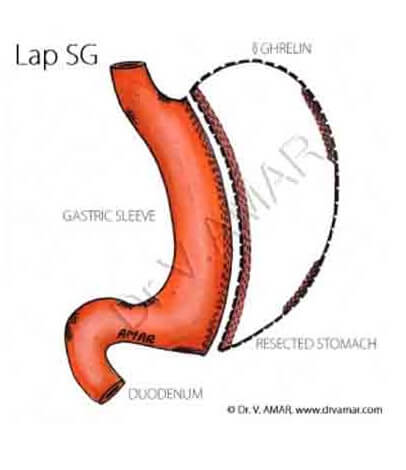Laparoscopic Surgery
Abdominal surgeries can be performed either by open method or by laparoscopic method. In laparoscopic surgery small holes are created to enter into the tummy. Telescope is kept inside the tummy. This is connected to a camera and camera is connected to a monitor. Surgery is performed by viewing in the monitor and using long thin instruments kept inside the tummy through small holes. As the holes are very small compared to open surgery, laparoscopic surgery is also called as minimal access surgery.
Open surgery is performed by cutting the tummy, while laparoscopic surgery is performed by creating small holes in the tummy. Surgery performed is more or less same in both types of surgeries. But method of access is different. Because of minimal access in laparoscopic surgery, patient will have certain advantages.
Patients will have significantly less post operative pain after laparoscopic surgery.
Reduced postoperative stay in the hospital.
Reduced complications like postoperative lung collapse and lung infections, blood clots in the legs.
Abdominal surgeries can be performed either by open method or by laparoscopic method. In laparoscopic surgery small holes are created to enter into the tummy. Telescope is kept inside the tummy. This is connected to a camera and camera is connected to a monitor. Surgery is performed by viewing in the monitor and using long thin instruments kept inside the tummy through small holes. As the holes are very small compared to open surgery, laparoscopic surgery is also called as minimal access surgery.
Open surgery is performed by cutting the tummy, while laparoscopic surgery is performed by creating small holes in the tummy. Surgery performed is more or less same in both types of surgeries. But method of access is different. Because of minimal access in laparoscopic surgery, patient will have certain advantages.
- Patients will have significantly less post operative pain after laparoscopic surgery.
- Reduced postoperative stay in the hospital.
- Reduced complications like postoperative lung collapse and lung infections, blood clots in the legs (deep vein thrombosis), ileus.
- Early return to the work.
- Wound infections and risk of hernias is less after laparoscopic surgery.
- Laparoscopic surgery is cosmetically excellent.
Complications are rare. During surgery bleeding, injury to intestines, bladder and other surrounding organs can occur. But these are rare as vision is excellent during laparoscopy and we take at most care to avoid injuries and we follow strict protocols in performing all types of surgeries. After surgery some patients may develop lung infections, lung collapse. Their bowels may not move for few days (ileus). Some patients may not be able to pass urine for a day or two (urinary retention). Blood clots may develop in legs because of lack of movement (deep vein thrombosis). All these problems are rare after laparoscopic surgery and can be managed without any severe consequences. Depending upon patient’s age and co-morbid conditions like diabetes, hypertension, heart disease, asthma, obstructive lung diseases, type of surgery (whether major or minor, emergency or elective) additional problems may develop in some patients in any type of surgery. These include heart attack, heart failure, delayed recovery from anaesthesia, need for prolonged ventilator support (patient will be connected to a machine to support breathing), need for prolonged ICU stay. Some complications are specific to each type of surgery. For example leak from suture or staple edges after dividing bowels etc.
Yes. In fact return to normal works will be early after laparoscopic surgeries.
After most of the laparoscopic surgeries, postoperative stay will be one to two days. But after certain major laparoscopic surgeries stay may extend from 4 to 7 days.
Generally as soon as you are fit you can go to work. It can be as early as 2 days. But generally most people return to office work after 1 week.
You can do routine physical activities from the next day after surgery. Exercise in the form of walking and jogging can be done after 3 to 7 days. You can start doing other forms of exercise after 3 weeks.
Surgeon will see you 1 week after surgery in general. Depending upon the type of surgery you may be advised to come for follow up again.
Usually after 2 weeks.
Usually after 1 week.
No. Surgery is nothing to do with weakness. If you do not eat food properly then you may become weak.
During the surgery we inflate the tummy with gas. But all the gas is removed before closing the entry sites. Your tummy increases in size if you eat high calorie food, and doesn’t do regular exercises. Surgery won’t increase your tummy size.
Long distance travel can be done after 2 weeks.
With few exceptions almost any surgery that can be performed by open method can be performed by laparoscopic method. Examples are laparoscopic bariatric surgeries for morbid obesity, laparoscopic metabolic surgeries for type 2 diabetes, laparoscopic mesh repair for inguinal and incisional hernias, laparoscopic esophagogastric, colorectal, pancreatic surgeries, laparoscopic fundoplication for reflux esophagitis, laparoscopic cardiomyotomy for achalasia cardia, total laparoscopic hysterectomy etc.,
Minimal Access Surgery
Diagnostic Laparoscopy
Laparoscopic Adhesiolysis
Laparoscopic Appendicectomy
Laparoscopic Cholecystectomy
Laparoscopic Inguinal Hernia Repair
Laparoscopic Incisional Hernia Repair
Laparoscopic Fundoplication
Laparoscopic Cardiomyotomy
Laparoscopic Esophageal Surgery
Laparoscopic Gastric surgery
Laparoscopic Small Intestinal Surgery
Laparoscopic Colon Surgery
Laparoscopic Rectal Surgery
Laparoscopic Perforation Closure
Laparoscopic Common Bile Duct Exploration
Laparoscopic Pancreatic Surgery
Laparoscopic Hepatic Surgery
Laparoscopic Splenectomy
Laparoscopic Tubo Ovarian Surgeries
Laparoscopic Myomectomy
Laparoscopic Hysterectomy
Laparoscopic Surgery for other diseases
For information on Laparoscopic Metabolic Surgery and Laparoscopic Bariatric Surgery
please see the corresponding sections.

